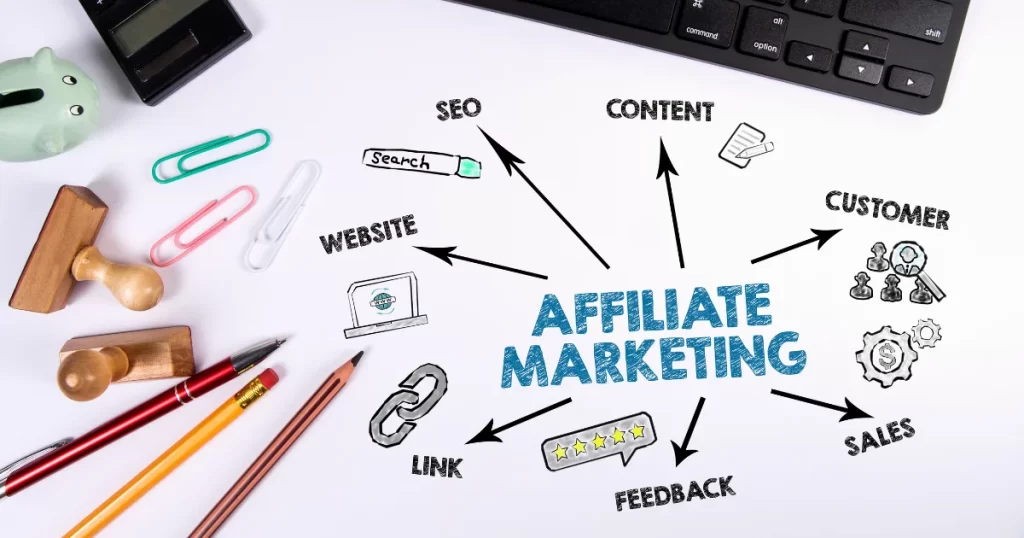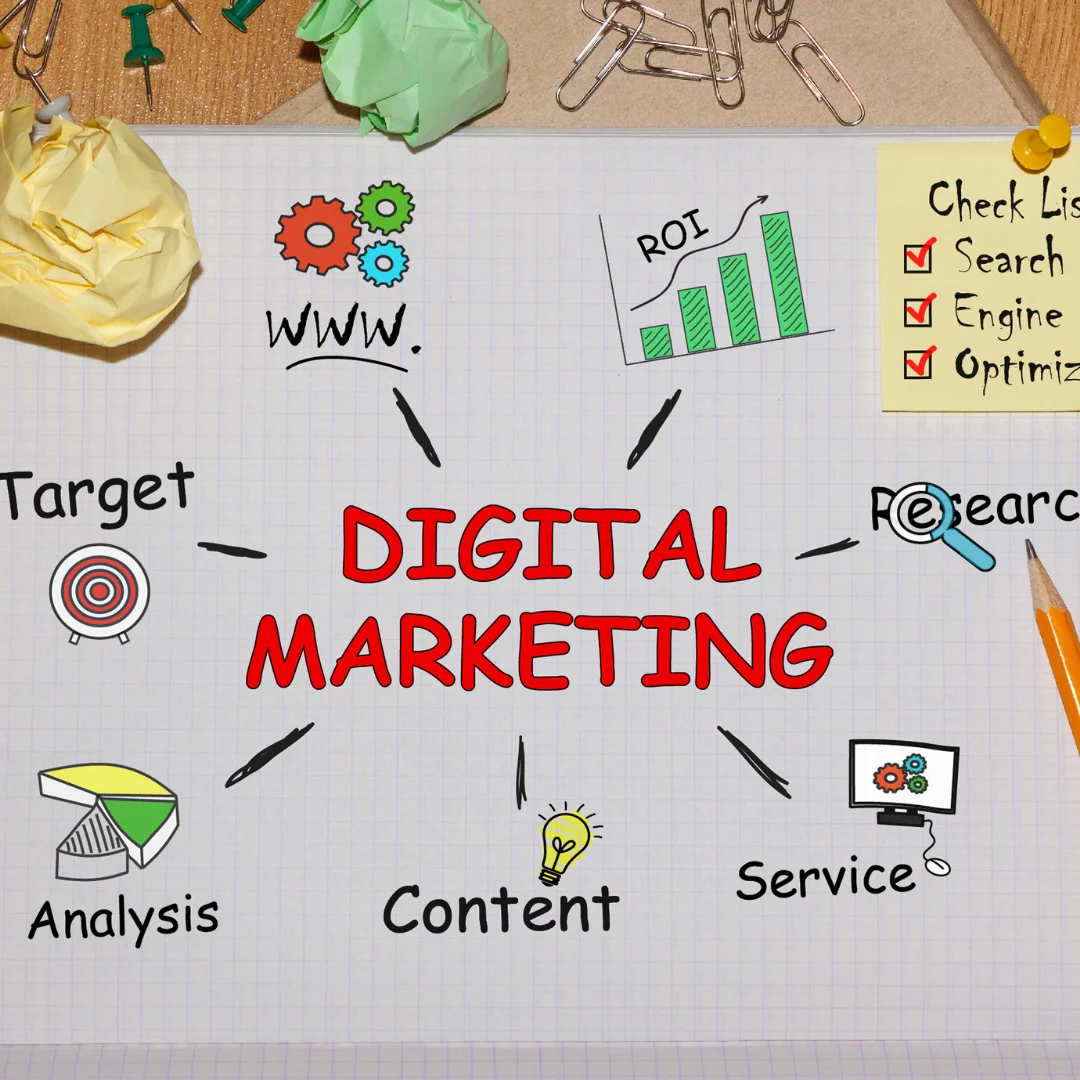
Affiliate marketing has emerged as one of the simplest and most popular ways to make money online, and it’s particularly enticing for beginners looking to generate passive income. With minimal startup costs and the flexibility to work from virtually anywhere, it offers a unique opportunity to participate in the digital economy without the need for personal product ownership or high upfront investment.
Affiliate marketing is built on a performance-based structure. This means that affiliates (like you) promote someone else’s products, and when a customer you refer makes a purchase, you earn a commission. Whether you’re a seasoned marketer or completely new to the field, affiliate marketing provides a flexible way to earn based on your efforts, offering the potential to scale over time and create a substantial income stream.
Key Takeaways
Here are the top advantages that make affiliate marketing ideal for beginners:
- Income Potential: Affiliates can earn passive income, and as long as your promotional content stays online, it continues to generate clicks and potential sales.
- Low Barrier to Entry: You don’t need to invest in inventory, handle shipping, or manage returns, which makes it easy to start with minimal resources and minimal risk.
- Scalability and Growth: Affiliate marketing rewards effort and growth. The more traffic you drive and the better you understand your audience, the higher your potential earnings. As you refine your strategies, there’s virtually no limit to the income you can generate.
What Is Affiliate Marketing?
Affiliate marketing revolves around three main parties:
- Merchants: The businesses or brands that offer the products you’re promoting.
- Affiliates: People like you who promote products or services and earn commissions on sales.
- Customers: Those who make purchases based on your promotions.
When structured effectively, affiliate marketing becomes a win-win model where affiliates (you) are rewarded for generating sales or leads, and merchants benefit from increased reach and sales without upfront costs for marketing.
Example: Imagine promoting a set of gardening tools on your blog. A reader clicks on your link, heads to the merchant’s website, and completes a purchase. To facilitate this sale, you earn a commission. If your blog post remains popular, it could continuously generate clicks, providing ongoing passive income with little to no ongoing effort.
Understanding Affiliate Marketing

Affiliate marketing is a performance-based business model that connects brands with individuals (affiliates) who promote their products or services in exchange for a commission on sales or other actions. This marketing approach is ideal for individuals aiming to monetize an online presence or digital skills without needing to create or stock their own products. The affiliate’s job is straightforward: promote a product or service effectively, drive traffic to the merchant’s site, and earn a commission when a specific action (such as a sale) occurs.
Affiliate marketing operates through various models that determine how affiliates are compensated. Depending on the merchant’s structure, affiliates can earn through pay-per-click (PPC), pay-per-sale (PPS), pay-per-lead (PPL), or even pay-per-impression (PPI).
Here’s a closer look at these essential affiliate marketing concepts.
The Performance-Based Marketing Model
At its core, affiliate marketing is about results: affiliates earn based on the success of their efforts, making it mutually beneficial for both the brand and the affiliate. In a performance-based marketing model, the brand pays only when the affiliate achieves a specified outcome, which might be:
- Driving Sales: The most common model, where affiliates earn a percentage or flat-rate commission for each sale.
- Generating Leads: Affiliates earn based on actions like form submissions, sign-ups, or other lead-generating activities.
- Clicks and Impressions: In rarer cases, affiliates earn based on clicks (PPC) or impressions (PPI), though these models are typically lower in payout.
Why Performance-Based Models Are Effective
The performance-based approach encourages affiliates to refine their marketing strategies since earnings are directly tied to effectiveness. This model provides flexibility, allowing affiliates to grow their income with improved techniques and stronger audience engagement.
| Affiliate Model | Description | Payment Trigger |
|---|---|---|
| Pay-per-sale (PPS) | Commission based on each sale generated through the affiliate’s link. | Product sale |
| Pay-per-lead (PPL) | Affiliate earns for each lead (e.g., form submission, sign-up) generated. | Qualified lead |
| Pay-per-click (PPC) | Payment for each click to the merchant’s website, regardless of conversion. | Website click |
| Pay-per-impression (PPI) | Earns based on the number of views or impressions an ad or link generates. | Ad view/impression |
Types of Commission Structures in Affiliate Marketing
The commission structure varies depending on the merchant’s policies and the type of product or service being promoted. Here’s a breakdown of the most common commission structures affiliates encounter:
1. Flat-Rate Commission
With a flat-rate model, affiliates earn a predetermined amount per sale or action, regardless of the purchase amount. This structure simplifies earnings calculation and is ideal for products or services with stable, consistent pricing, such as:
- Subscription services (e.g., streaming platforms or software)
- Single-purchase products (e.g., physical goods with set prices)
Pros:
- Predictable earnings for each successful conversion.
- Simplifies tracking and estimating earnings.
Cons:
- Limited earnings potential, especially for high-value sales where a percentage might yield more income.
2. Percentage-Based Commission
Percentage-based commissions offer a more scalable earning opportunity, as affiliates earn a percentage of each sale’s value. This model is common in e-commerce and works well when affiliates target high-value products. For example, if a merchant offers a 10% commission and an affiliate drives a $200 sale, they would earn $20.
Pros:
- Higher earnings potential for promoting high-ticket items.
- Motivates affiliates to target premium products or upsell when possible.
Cons:
- Commission variability, depending on the sale amount.
- Requires tracking higher-ticket products and focusing on conversions over volume.
3. Recurring Commission
Recurring commissions provide affiliates with long-term income potential by offering payouts on a recurring basis for each renewal or ongoing payment made by the customer. This structure is popular in Software-as-a-Service (SaaS) and subscription-based services.
Pros:
- Passive income stream as long as the referred customer remains active.
- Encourages affiliates to drive quality, long-term customer relationships.
Cons:
- Lower initial payouts compared to single, high-ticket commissions.
- Earnings fluctuate with customer retention and churn rates.
How Affiliate Marketing Models Benefit Affiliates and Merchants
Affiliate marketing benefits both the affiliate and the merchant due to its performance-based nature, low upfront costs, and extensive reach. Here’s a breakdown of these benefits:
| Benefit to Affiliate | Benefit to Merchant |
|---|---|
| No need to create or stock products | Pay only for results, reducing ad costs |
| Flexible work location and hours | Wider audience reach through affiliates’ diverse channels |
| Scalable earning potential with low barriers | Access to new markets without extra effort |
| Choice of commission model and products | Increased credibility from trusted affiliate endorsements |
Practical Examples of Commission Structures
Let’s dive into some examples to illustrate how these models function in real-world affiliate programs.
| Program/Platform | Type of Product | Commission Structure | Example Outcome |
|---|---|---|---|
| Amazon Associates | Physical Products | Percentage-Based | Earns 4%-10% commission, depending on product category |
| ClickBank | Digital Products | Percentage or Flat-Rate | Offers high commissions, often 50% or more, for eBooks and courses |
| AWeber Affiliates | Email Marketing SaaS | Recurring Commission | Earns 30% recurring on each customer subscription |
| Shopify Affiliates | E-commerce SaaS | Flat Rate (per sale) | Earns $58 for each paid plan customer referral |
Advantages of Affiliate Marketing for Beginners

Affiliate marketing has quickly become a go-to business model for beginners interested in the world of digital entrepreneurship. Here’s why this flexible, low-investment approach is ideal for those just starting out.
1. Passive Income Potential
Affiliate marketing opens up the potential to earn passive income, a major appeal for many beginners. When you set up an affiliate campaign or create content with affiliate links, that content remains online, working for you 24/7. This means you can generate income from each purchase made through your link long after the initial effort. The goal of affiliate marketing is to create a continuous stream of income with minimal ongoing input, allowing affiliates to enjoy:
- Compounded Earnings: Each new piece of content (like blog posts, social media posts, or videos) serves as another income source.
- Long-Term Value: Content can continue generating clicks and sales as long as it’s accessible online.
| Passive Income Advantages | Description |
|---|---|
| Low Ongoing Effort | Minimal maintenance after initial setup |
| Income Scaling | Increased potential as more content is published |
| Automated Sales | Income from sales without direct involvement |
2. Low Entry Costs
Affiliate marketing doesn’t demand a hefty initial investment, making it ideal for beginners who want to start earning without large upfront costs. Unlike traditional business models where you’d need to buy, store, and manage inventory, affiliate marketing allows you to skip those steps entirely. Here’s why low entry costs are a major advantage:
- No Inventory Costs: Affiliates don’t need to stock or buy products upfront, eliminating the risk of unsold inventory.
- No Warehousing Needs: Since you’re only promoting products, there’s no need to pay for storage or worry about product handling.
- No Shipping or Fulfillment Hassles: These responsibilities lie with the merchant, meaning affiliates don’t deal with packing or shipping.
This low-cost setup allows you to focus on promoting high-quality products without being bogged down by traditional business expenses.
| Affiliate Marketing Cost Benefits | Details |
|---|---|
| No Inventory Investment | Eliminates financial risk of unsold products |
| No Fulfillment Costs | Avoids handling and shipping expenses |
| Minimal Start-Up Fees | Many affiliate programs are free to join |
3. Flexibility and Independence
Affiliate marketing’s flexibility and independence make it appealing for people who want to work on their own terms. You can set your own schedule, adapt your approach, and choose where and how to work. Here’s how affiliate marketing provides this flexibility:
- Work from Anywhere: As long as there’s internet access, affiliates can work from any location, whether that’s from home, a cafe, or even on vacation.
- Set Your Own Hours: There’s no set schedule, so you can choose to work whenever it suits you best, making it an ideal side hustle or a main source of income.
- Freedom to Adapt and Scale: You have control over which products you promote and can easily adjust strategies based on your goals and audience feedback.
| Flexibility Benefits | Description |
|---|---|
| Work from Anywhere | No need for a fixed office space |
| Choose Your Schedule | Flexibility to work around other commitments |
| Customizable Approach | Freedom to adjust and experiment with strategies |
4. No Product Ownership Needed
A standout benefit of affiliate marketing is that affiliates promote products they don’t own or handle. There’s no need to worry about customer service, product management, or fulfillment, as these are the merchant’s responsibilities. This allows you to focus solely on marketing, which is often more convenient and less time-consuming.
What This Means for You:
- No Customer Service Hassles: Issues like returns, complaints, or inquiries are handled by the merchant, not the affiliate.
- Product Management is Covered: Inventory, packaging, and logistics are handled by the brand or retailer.
- Reduced Risk: Without product ownership, you can experiment with promoting different items and niches without the financial risks tied to physical inventory.
| Benefits of No Product Ownership | Details |
|---|---|
| No Customer Support Needed | Merchants handle service inquiries and issues |
| No Inventory Risks | No need to worry about stock or product availability |
| Focus on Marketing Only | Affiliates concentrate on promotion rather than product management |
Additional Advantages of Affiliate Marketing
- Scalability: As your audience grows, so does your potential income. Affiliates can increase earnings by diversifying products, expanding platforms, and reaching wider audiences.
- High Earning Potential: With commitment and strategy, there’s potential to earn substantial income over time. Many affiliates make a living solely from their commissions.
- Variety of Niches: From fitness to finance, tech to travel, the vast array of affiliate products allows you to select a niche that aligns with your interests or expertise.
Step-by-Step Guide to Starting Your Affiliate Marketing Journey

Starting in affiliate marketing involves key foundational steps. Each step, from niche selection to content creation, helps ensure your efforts are profitable and sustainable. Here’s a roadmap to get started.
1. Choosing Your Niche Carefully
Choosing the right niche is the first critical decision in affiliate marketing. The ideal niche aligns with your interests, making it easier to create engaging content consistently. Additionally, a niche with proven demand can significantly increase your earnings potential.
- Research Niche Demand: Using tools like Google Trends and Keyword Planner, you can explore niches and check their popularity over time. This helps you understand if your chosen niche has a steady or growing audience.
- Evaluate Profit Potential: To see if your niche is profitable, research related affiliate programs and the types of commissions offered. Consider both the commission rate and demand for products in your niche.
“Content is king but engagement is queen.”
– Mari Smith
| Niche Selection Tips | Details |
|---|---|
| Interest & Knowledge | Choose a topic you’re familiar with to ease content creation |
| Steady Demand | Select a niche with a proven audience using research tools |
| Profitability | Verify the niche’s profit potential by examining affiliate programs |
2. Researching and Joining Relevant Affiliate Programs
After deciding on a niche, the next step is to find affiliate programs that fit. Research different affiliate networks and assess their offerings, making sure they align with your niche and content strategy. Both physical and digital product programs are available, and each has unique advantages:
- Physical vs. Digital Products: Physical products, like electronics or household items, often have higher conversion rates but lower commission percentages. Digital products, such as online courses or software, tend to offer higher commission rates but may require more targeted promotion.
- Affiliate Networks: Joining affiliate networks like Rakuten, ShareASale, and Impact can provide access to a wide range of programs. These networks simplify the application process and help you manage your promotions from a single platform.
| Product Type | Advantages | Disadvantages |
|---|---|---|
| Physical Products | Higher conversion rates | Lower commissions |
| Digital Products | Higher commissions | May require niche audiences |
| Affiliate Networks | Easy management | May have minimum payouts |
3. Building Your Online Platform for Success
An effective online platform is essential for affiliate marketing success. Depending on your audience and content format, you may opt for a blog, website, or social media presence. Your choice of platform will impact how you reach and engage your audience.
- Setting Up a Blog or Website: A blog or website allows you to create long-form content and in-depth product reviews, which can help build trust and authority with your audience.
- Social Media Presence: Platforms like Instagram, Facebook, or TikTok provide access to broad audiences but may require frequent, short-form content to keep engagement high.
| Platform Type | Pros | Cons |
|---|---|---|
| Blog/Website | Long-term content, SEO value | Requires setup time |
| YouTube | High engagement, visual appeal | Time-intensive video production |
| Social Media | Broad reach, quick start | Limited content lifespan |
4. Creating Compelling Content That Drives Conversions
In affiliate marketing, content quality is crucial to driving conversions. High-quality content that provides genuine value attracts an audience and builds credibility. Here’s how to create content that encourages your audience to engage with your affiliate links:
- Types of Affiliate Content: Popular formats include product reviews, comparisons, how-to guides, and tutorials. These types of content help educate the audience about the products, improving conversion chances.
- Focus on Value: Always prioritize offering solutions and value in your content, rather than directly pushing for sales. When you genuinely help your audience, trust builds naturally, making them more likely to click through and convert.
“The best way to predict the future is to create it.”
– Peter Drucker
| Content Type | Benefits | Best Practices |
|---|---|---|
| Product Reviews | In-depth, targeted content | Be honest and transparent |
| How-To Guides | Educative, engages audience | Use step-by-step approach |
| Comparison Articles | Helps audience make decisions | Highlight key features |
5. Promoting Your Affiliate Products Effectively Across Channels
Promotion is key to expanding your reach and driving conversions. By using multiple channels, you can effectively connect with different segments of your audience. Here’s a breakdown of the primary promotion methods:
- Social Media: Platforms like Instagram, Facebook, and Twitter allow you to share affiliate content with a broad audience. For effective social media promotion, use engaging visuals, catchy captions, and relevant hashtags.
- Email Marketing: Building an email list enables you to reach a more dedicated audience, as people who subscribe to your emails are already interested in your content. With email marketing, you can nurture relationships, recommend products, and share exclusive offers.
- SEO Optimization: Optimizing your content for search engines ensures that it ranks higher, attracting organic traffic. This involves targeting relevant keywords, like “Affiliate Marketing,” which drives traffic from search engines.
| Promotion Channel | Key Advantage | Recommended Tactics |
|---|---|---|
| Social Media | Broad reach, visual engagement | Use visuals, hashtags |
| Email Marketing | Dedicated, interested audience | Build trust, offer value |
| SEO Optimization | Organic, long-term traffic source | Target keywords, on-page SEO |
Essential Tools and Resources for Successful Affiliate Marketers

In affiliate marketing, using effective tools can streamline your work, improve efficiency, and boost results. Each tool serves a unique purpose, from SEO optimization to content creation and performance tracking, making it easier to focus on creating quality content and reaching your audience.
1. SEO Tools: Improving Content Visibility
SEO tools help make your content visible in search engine results, bringing organic traffic to your platform. By optimizing keywords, understanding user behavior, and analyzing rankings, you can effectively increase the reach of your affiliate content.
| SEO Tool | Purpose | Other Example Tools |
|---|---|---|
| Rank Math | On-page SEO, keyword analysis | Rank Math, Yoast |
| Google Analytics | Website performance tracking | Google Analytics |
| Moz | Backlink analysis, keyword tracking | Moz, Ahrefs |
2. Email Marketing: Building and Nurturing an Audience
Email marketing is essential for building a dedicated audience interested in your affiliate content. With email marketing tools, you can automate campaigns, segment lists, and track performance, helping nurture relationships over time and ultimately improve conversion rates.
| Email Marketing Tool | Purpose | Other Example Tools |
|---|---|---|
| MailChimp | Automated campaigns, analytics | MailChimp, Constant Contact |
| ConvertKit | List segmentation, email automation | ConvertKit, AWeber |
3. Analytics: Tracking Performance and User Behavior
Analyzing performance is essential to understand what’s working and what needs improvement. Analytics tools help track user behavior, conversion rates, and engagement, which in turn can help refine your affiliate strategy for better results.
| Analytics Tool | Purpose | Other Example Tools |
|---|---|---|
| Google Analytics | Tracks website traffic, conversions | Google Analytics, Clicky |
| Hotjar | Visual behavior tracking, heatmaps | Hotjar, Crazy Egg |
4. Content Creation: Generating High-Quality Visuals
Visual content like images and infographics is crucial in affiliate marketing, especially on social media and blogs. High-quality visuals make your content more engaging and can effectively highlight affiliate products.
| Content Creation Tool | Purpose | Other Example Tools |
|---|---|---|
| Canva | Graphics, social media images | Canva, Adobe Spark |
| Unsplash | High-quality stock images | Unsplash, Pexels |
5. Keyword Research: Identifying High-Demand Keywords
To succeed in affiliate marketing, you need to understand which keywords attract the most traffic. Keyword research tools reveal high-demand keywords related to your niche, helping you target topics that your audience is already interested in.
| Keyword Research Tool | Purpose | Other Example Tools |
|---|---|---|
| Ahrefs | Comprehensive keyword analysis | Ahrefs, SEMrush |
| Google Keyword Planner | Keyword ideas, trends | Google Keyword Planner, Keysearch |
“You don’t have to be great to start but you have to start to be great.”
– Zig Ziglar
Building Trust with Your Audience Through Transparency and Honesty

A key element in successful affiliate marketing is trust. When readers feel confident in your recommendations, they’re more likely to make purchases through your links and return to your content for guidance. Transparency and honesty help cultivate this trust, making it clear to readers that your primary goal is to offer value, not just to earn commissions.
In affiliate marketing, being transparent about affiliate relationships, maintaining authenticity in product reviews, and engaging openly with your audience establishes a foundation of credibility that can set you apart.
Why Transparency Matters in Affiliate Marketing
Transparency reassures readers that your recommendations are genuine, even when you stand to gain from them. Studies show that consumers are more likely to purchase when they feel the source is trustworthy. By being transparent about affiliate relationships, you demonstrate integrity, which encourages readers to support your content through affiliate links.
Let’s explore specific techniques to build trust through transparency and authenticity.
Techniques for Building Trust in Affiliate Marketing
1. Honest Reviews
Balanced and honest reviews are fundamental to earning the trust of your audience. Sharing both the benefits and drawbacks of products establishes credibility, signaling that you genuinely aim to provide helpful, reliable information rather than just pushing a sale. Here’s how to approach honest reviews:
- Discuss Pros and Cons: Describe both the features that make the product valuable and any limitations or drawbacks.
- Be Specific: Mention unique attributes that differentiate the product, and provide examples of how it meets user needs.
- Avoid Overhyping: Overly promotional language can appear disingenuous. Keep your tone grounded and relatable.
| Honest Review Tips | Explanation |
|---|---|
| Share Pros and Cons | Offer a balanced view to help readers make informed choices |
| Use Real Examples | Describe product features and their practical benefits |
| Avoid Overly Positive Language | Keeps reviews realistic and authentic |
Tip: Your audience will appreciate an honest review, even if it’s not 100% positive. Balance is key.
2. Disclosure of Affiliate Relationships
Disclosing affiliate relationships is both a legal requirement (per FTC guidelines) and an essential part of building reader trust. Affiliate disclosures make it clear that your recommendation is potentially profitable for you, helping readers understand the nature of your content and reinforcing that you prioritize transparency.
- Place Disclosure Prominently: Include a brief, clear disclosure at the beginning of blog posts, social media captions, or video descriptions.
- Use Simple Language: Phrases like “As an affiliate, I may earn a commission on qualifying purchases” are straightforward and reader-friendly.
- Be Consistent: Ensure disclosures are present across all content, from blog posts to emails and social media.
| Affiliate Disclosure Tips | Explanation |
|---|---|
| Use Clear Language | Readers should easily understand your affiliate role |
| Position Disclosure Prominently | Early in content to avoid misunderstandings |
| Consistent Across Platforms | Maintain disclosures in blogs, videos, and emails |
Tip: Readers value honesty, so never hide your affiliate relationship. Instead, embrace it as part of a transparent content approach.
3. Engagement with Readers
Engagement creates a personal connection with your audience, transforming passive followers into active supporters. Interacting with readers through comments, emails, or social media fosters a sense of community and provides opportunities to address questions, clarify recommendations, and build rapport.
- Respond to Comments Promptly: Reply to questions, acknowledge compliments, and clarify any points that readers find confusing.
- Encourage Feedback: Ask for the reader’s opinions or experiences with recommended products, making them feel valued.
- Share Personal Insights: Occasionally share your own experiences with the products, which adds a personal touch and strengthens relatability.
| Audience Engagement Tips | Explanation |
|---|---|
| Reply to Comments | Shows you value readers’ input and are available for them |
| Encourage Feedback | Makes readers feel part of the conversation |
| Add Personal Experiences | Strengthens relatability and builds authenticity |
4. Focusing on Value over Selling
The most successful affiliate marketers prioritize offering value over making quick sales. Content that genuinely helps readers—whether through tutorials, comparisons, or detailed reviews—naturally drives conversions because it builds trust and positions you as a reliable resource.
- Provide Educational Content: How-tos, comparisons, and guides help users make informed decisions, positioning you as a trusted authority.
- Avoid Pushy Language: Rather than hard-selling, let the quality of information naturally promote the product.
- Encourage Informed Decisions: Guide readers toward solutions that best fit their needs rather than the most profitable options for you.
| Value-First Content Tips | Explanation |
|---|---|
| Educate Over Sell | Guides, how-tos, and comparisons provide valuable insights |
| Avoid Pushy Language | Prioritizes reader needs over profit |
| Encourage Informed Choices | Shows commitment to helping readers decide |
Remember: When readers sense genuine effort to help them, they’ll return, often ready to support your content through affiliate links.
Summary of Techniques for Building Trust in Affiliate Marketing
| Trust-Building Technique | Description |
|---|---|
| Honest Reviews | Balanced pros and cons for authentic product insights |
| Affiliate Disclosure | Clear and consistent across all content |
| Audience Engagement | Active interaction through comments and feedback |
| Value-First Approach | Focus on educating rather than hard-selling |
Avoiding Common Pitfalls on Your Affiliate Marketing Journey

Starting in affiliate marketing can be exciting, but the journey comes with its own set of challenges. Many beginners encounter common pitfalls that can hinder their growth and credibility if not addressed early. By knowing what these potential mistakes are, you’ll be better prepared to navigate around them and build a sustainable affiliate marketing strategy.
Below, we break down three common pitfalls in affiliate marketing and provide practical tips on how to avoid each one.
1. Overloading Links
Too many affiliate links can overwhelm your audience and make your content appear solely sales-driven, which can impact credibility and diminish the reader’s trust. When every sentence seems linked to a product, it can feel forced, which may turn readers away or even harm your site’s SEO.
Why It’s a Pitfall
Overloading links dilutes the quality of content, making it feel like a pitch rather than a genuine resource. Excessive linking can also hinder SEO performance, as search engines prioritize valuable, user-friendly content. Too many links might also slow down page load times, which affects user experience and rankings.
How to Avoid Overloading Links
- Be Selective with Links: Only include affiliate links where it makes sense and genuinely adds value to the reader’s experience.
- Limit Link Frequency: Aim to link no more than one affiliate link per every 200-300 words.
- Use Affiliate Links Strategically: Place links in high-traffic areas like the introduction or call-to-action sections where users are most likely to click.
| Tip for Affiliate Link Management | Benefit |
|---|---|
| Use links sparingly | Keeps content clean and credible |
| Place links strategically | Boosts click-through rates without feeling forced |
| Avoid linking in every sentence | Reduces the risk of overwhelming the reader |
Remember: It’s more impactful to have a few well-placed links than to overload your content.
2. Ignoring SEO
One of the most critical components of affiliate marketing is the ability to attract organic traffic. Neglecting SEO can limit your reach and lead to slower growth. Without SEO optimization, even the best content can go unnoticed, reducing the potential for traffic and conversions.
Why It’s a Pitfall
SEO helps your content rank on search engines, making it easier for readers to discover you. Without it, you’re dependent solely on direct traffic and social media, which can be inconsistent sources. Additionally, well-optimized content improves user experience by delivering what users search for, leading to higher rankings and traffic over time.
How to Avoid Ignoring SEO
- Conduct Keyword Research: Use tools like Ahrefs, SEMrush, and Google Keyword Planner to find relevant keywords. Look for high-volume, low-competition keywords that align with your niche.
- Optimize On-Page Elements: Ensure keywords are included in your headings, meta descriptions, and image alt text.
- Focus on Content Quality: High-quality, value-driven content is the foundation of SEO. Aim to answer reader questions and provide actionable insights.
| SEO Optimization Tips | Explanation |
|---|---|
| Use targeted keywords | Increases search visibility for relevant topics |
| Optimize on-page elements | Helps search engines understand your content |
| Prioritize quality content | Drives organic traffic and improves reader experience |
Pro Tip: Regularly update your content to keep it relevant and maintain SEO rankings.
3. Promoting Low-Quality Products
One of the quickest ways to lose your audience’s trust is by promoting low-quality or irrelevant products. Affiliate marketing works best when your recommendations are valuable and align with the needs of your readers. Promoting products that disappoint users reflects poorly on your brand, leading to lost trust and, potentially, lost readership.
Why It’s a Pitfall
Low-quality products lead to high refund rates and negative feedback, ultimately damaging your credibility. Readers will likely stop clicking on your links or following your recommendations if they feel misled. Additionally, reviews or complaints about products you promote can also affect your reputation.
How to Avoid Promoting Low-Quality Products
- Vet Products Thoroughly: Research each product’s features, customer reviews, and refund policy to ensure it meets your standards.
- Prioritize Value Over Commission: Choose products that genuinely solve your audience’s problems, even if they offer lower commissions.
- Test the Products Yourself: Whenever possible, try the products yourself. Firsthand experience can offer valuable insights to share with your readers.
| Tips for Selecting Quality Products | Benefit |
|---|---|
| Research product reviews | Ensures the product has a positive reputation |
| Focus on value over commission | Builds audience trust and encourages long-term support |
| Try products firsthand | Provides authentic and helpful insights |
Key Takeaway: Building a loyal following in affiliate marketing means prioritizing the reader’s experience over short-term profits.
Inspiring Real-Life Success Stories from the World of Affiliate Marketing

Nothing motivates quite like seeing real-life success stories, especially when they illustrate the potential of affiliate marketing. These case studies showcase different approaches to affiliate marketing and provide insights into the strategies that led to their growth. From beginners building income streams from scratch to established brands expanding their reach, these success stories highlight the diverse paths to success in affiliate marketing.
Case Study 1 – Location Rebel Academy
Location Rebel Academy is a prime example of starting small and scaling up through niche-focused content. Sean Ogle, the founder, began his journey with minimal investment, creating a blog that provided resources, advice, and strategies for those interested in building a location-independent business. By focusing on valuable content targeted at a specific audience, he was able to turn Location Rebel Academy into a popular and profitable resource.
Key Elements of Success
- Targeted Niche: Location Rebel Academy appealed to aspiring digital nomads and freelancers, catering to a well-defined, passionate audience. This specificity helped attract readers genuinely interested in the content.
- High-Quality Content: Sean prioritized quality over quantity, focusing on creating detailed guides and tutorials that addressed real questions from his audience. This approach built trust and established him as an authority in his niche.
- Consistency and Patience: Instead of expecting overnight success, Sean maintained a steady pace, consistently publishing valuable content. Over time, this consistency led to significant growth and a loyal audience base.
- Effective Use of Affiliate Links: Location Rebel Academy incorporated affiliate links subtly within the content, always ensuring they added value rather than disrupting the reader’s experience.
- Community Building: Sean didn’t just publish content; he fostered a community by encouraging reader engagement and interaction. This sense of community fostered loyalty, making readers more likely to return and convert.
| Strategy | Benefit |
|---|---|
| Focus on a targeted niche | Attracted a highly engaged, relevant audience |
| Prioritize quality content | Built trust and authority in the niche |
| Maintain consistency | Drove steady, long-term growth |
| Use affiliate links subtly | Enhanced monetization without disrupting content |
| Foster community | Created loyal readership and higher conversion rates |
Lesson Learned: Starting small with a focused niche and a commitment to high-quality, consistent content can yield significant results over time in affiliate marketing.
Case Study 2 – WP Engine
While many affiliate marketing stories feature individuals, WP Engine is a great example of how an established brand can leverage affiliate marketing to expand its reach and acquire new customers. WP Engine, a premium managed hosting provider, tapped into affiliate marketing as a way to access new audiences in a cost-effective manner.
Key Elements of Success
- Quality Partnerships: WP Engine partnered with reputable affiliates, often influencers or bloggers with a solid following in the web hosting or WordPress niche. This approach ensured that the brand was exposed to a targeted, high-quality audience.
- Strong Affiliate Support: WP Engine provided affiliates with resources such as high-converting ad creatives, detailed product information, and training materials. This support helped affiliates promote the brand effectively and consistently.
- Performance-Based Incentives: WP Engine incentivized affiliates with attractive commission rates and performance-based rewards, encouraging affiliates to drive higher volumes and quality of leads.
- Content Marketing Focus: Many WP Engine affiliates created valuable, educational content around web hosting, WordPress, and related topics. This content not only drove traffic but also positioned WP Engine as a reliable solution for readers actively seeking hosting services.
- Clear Brand Messaging: WP Engine maintained consistent messaging across its affiliates’ content, reinforcing its brand image as a premium hosting provider for serious users, businesses, and developers.
| Strategy | Benefit |
|---|---|
| Partner with reputable affiliates | Ensured access to high-quality, relevant audiences |
| Offer strong affiliate support | Enabled affiliates to promote effectively |
| Use performance-based incentives | Motivated affiliates to drive more conversions |
| Focus on content marketing | Drove targeted traffic and positioned WP Engine as a top solution |
| Maintain consistent brand messaging | Reinforced brand image and trustworthiness |
Lesson Learned: Established brands can benefit significantly from affiliate marketing by partnering with quality affiliates, providing them with effective resources, and incentivizing performance. This approach can expand brand reach, attract quality leads, and boost conversions.
Case Study 3 – Michelle Schroeder Gardner’s “Making Sense of Cents”
Michelle Schroeder-Gardner, the creator of Making Sense of Cents, turned a personal finance blog into a six-figure income source largely through affiliate marketing. Michelle’s journey started with a passion for sharing budgeting and financial advice, which quickly found a loyal audience. Through strategic affiliate marketing, she scaled her blog into a lucrative venture.
Key Elements of Success
- Focus on Reader Needs: Michelle’s blog posts were crafted with the reader’s needs in mind, providing practical advice on budgeting, debt repayment, and side hustles. This reader-focused approach made affiliate recommendations feel natural and helpful.
- Comprehensive Product Reviews: When promoting financial products, Michelle created detailed reviews that covered all aspects, pros, cons, and personal experiences with the products. This thorough approach helped her build trust with readers.
- Transparency and Honesty: Michelle always disclosed her affiliate relationships and explained the potential benefits readers could gain from using recommended products. This honesty resonated with her audience, making them more inclined to follow her recommendations.
- Courses and Ebooks: Michelle expanded her affiliate marketing strategy by offering educational resources, such as an affiliate marketing course. These resources created additional income streams and reinforced her authority in affiliate marketing.
| Strategy | Benefit |
|---|---|
| Focus on reader needs | Built loyalty and made affiliate links relevant |
| Create detailed product reviews | Increased reader trust and conversion rates |
| Practice transparency and honesty | Enhanced credibility with readers |
| Develop courses and ebooks | Expanded income streams and established authority |
Lesson Learned: By addressing audience needs, offering comprehensive product insights, and being transparent, you can build a loyal following and achieve impressive affiliate income.
Conclusion: Taking Action Toward Your Own Successful Affiliate Marketing Journey!
Affiliate marketing opens the door to financial independence, flexibility, and the possibility of creating a sustainable online business. By choosing the right niche, building a strong platform, and engaging with your audience, you can set the foundation for long-term success. Taking the first step is the key to a successful journey, so start small, stay consistent, and keep refining your approach as you go.





